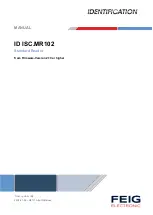
-
14 -
-
DHCP: DHCP servers are a part of numerous LAN management systems. The DHCP field has two
selections, “Enable” or “Disable”. Arrow to the desired selection and select enter. When enabled,
SCB-A08 will send a DHCP request to the DHCP server, which will assign a dynamic IP address, netmask,
and gateway to the SCB-A08. If a DHCP server is not available on the network the SCB-A08 will time out
after 10 seconds and the default values will remain. When DHCP is enabled, the IP address, Netmask and
Gateway fields become inaccessible and cannot be changed by the user.
-
IP address: SCB-A08 default IP address is 192.168.2.1. A static IP address can also be assigned in this
section of the menu. A dynamic address assigned by the DHCP server may change if the SCB-A08 loses
the Ethernet connection or power is removed. The host (client) communication software requests a
connection to the specific IP address of the serial server. If the DHCP reassigns a different IP address the
software will not be able to communicate with the hardware. It is recommended to use a static IP
address. A static IP address is permanent and will not change unless changed in the menu. In most cases
the network administrator establishes the static address to be use.
-
Netmask: The default LAN netmask is configured for a Class C address. This may reconfigured by the user.
-
MAC address: The MAC address is not adjustable. This is assigned in the factory. Every Ethernet device
manufactured has its own unique MAC address.
-
Version & Date: The currently loaded version of the firmware, and when it was released, are shown here.
-
Link status: Link status automatically displays the type of Ethernet connection. It will either display 10 BaseT
or 100BaseTX in full duplex or half duplex. This will depend on the LAN, switches, hubs used in the LAN
topology.
-
Serial port:
This field indicates the number of the port for with serial server properties are currently being
displayed. Changing the number in this field will cause all the other fields to display the properties for the
specified port. Before changing ports, any change to properties must be Updated (Saved) or SCB-A08
will not retain them. Suggest use default setting.
-
Baud rate: The serial port baud rate on SCB-A08 must match the serial baud rate of the connected
device. (Suggest use default setting)
-
Data/Parity/Stop: This setting will have to match the data format of the connected device. (Suggest use
default setting)
-
Flow control: The flow control setting must match the connected serial device. (Suggest use default
setting)
-
Protocol: Select TCP or UDP protocol. If the application does not require a UDP connection, select TCP.
TCP guarantees reliable communication with error checking whereas UDP provides faster transmission.
When UDP mode is chosen the Serial timeout, TCP alive timeout, Connection mode, Connection at,
Maximum connection and Remote IP address fields are replaced with the following three fields:
Destination IP address range, Port number and Source IP address range. In this mode the server can be
configured to broadcast data to and receive data from multiple IP addresses. Four IP address range
fields are provided. (Suggest use default setting)
-
Serial timeout: Default is 0, or no timeout. Setting timeout to any value between 1 and 65535 seconds
activates it. If communications are idle for specified timeout value the serial server will reset and make
itself available for another connection. (Suggest use default setting)
-
TCP alive timeout: This monitors TCP activity. If TCP activity stops for the length of time specified in this field
the connection will be closed. This field can be set to any value between 0 and 255 minutes. If zero, or no
value, is entered into this field the server will not disconnect. (Suggest use default setting)
-
Connection mode: The Connection mode field has three options, Server, Client and Client (no
heartbeat). When Client or Client (no heartbeat) is selected, the Connection at field automatically
becomes active (allowing the user to select Power up or Data arrival). (Suggest use default setting)
When using the Virtual COM Port feature, select Server.
When using a TCP or UDP Socket program, select Server.
When using Paired Mode communication between two serial servers set up one as a Client and the
other as a Server.
User Manual







































